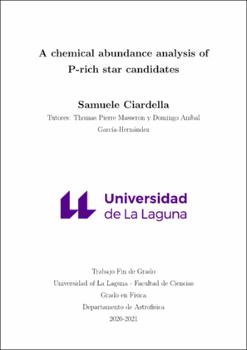A chemical abundance analysis of P-rich star candidates
Autor
Ciardella, SamueleFecha
2021Resumen
In this memory will be analysed the work done on the spectra of 39 stars to determine if
they can be included in the group of the P-rich stars, stars whose abundance of phosphorus is
higher than average.
These stars are very important in order to explain the origin of the phosphorus found in our
galaxy, currently underpredicted by chemical evolution models. On the other hand, last year
were released an article that, analysing data from the APOGEE survey, presents the discovery
of the existence of stars with an abundance of P higher than normal, called P-rich [1]. In a
second work, were shown 39 stars with anomalies in their composition.[2] This project had as
objective to determine if these 39 stars were P-rich and if they presented a correlation between
P and other elements (O,Mg, Al,Si and Ce). To do this we used the data, provided by the
APOGEE database, of the stars studied (H-band spectra, effective temperature, surface gravity
and abundance of carbon, nitrogen and alpha elements, among others) as initial data of the
spectral synthesis code BACCHUS, which provided the abundance of phosphorus and cerium
of these stars. We found that 37 stars (∼90%) are very rich in P ([P/Fe]>=1 dex) and rich
in Ce ([Ce/Fe]>0 dex). Then, we compared the P and Ce abundances with those from other
elements as well as with those observed in other stars with similar atmospheric parameters. We
found that there is indeed the possibility of a correlation between phosphorous and oxyge, as
well between O and Si and between Al and Mg. En esta memoria se analizar´a el trabajo realizado sobre los espectros de 39 estrellas para
determinar si pueden incluirse en el grupo de estrellas P-rich, estrellas cuya abundancia de
f´osforo es superior a la media.
Estas estrellas son muy importantes para explicar el origen del f´osforo que se encuentra en
nuestra galaxia, actualmente infraprevisto por los modelos de evoluci´on qu´ımica. Por el otro
lado, el a˜no pasado se public´o un art´ıculo que, analizando datos de la encuesta APOGEE, presenta el descubrimiento la existencia de estrellas con una abundancia de P m´as alta de lo normal,
llamada P-rica [1]. En un segundo trabajo, fueron mostradas 39 estrellas con anomal´ıas en su
composici´on. [2] Este proyecto tuvo como objetivo determinar si estas 39 estrellas eran ricas en
P y si presentaban una correlaci´on entre P y otros elementos (O,Mg, Al,Si y Ce). Para ello se
utilizaron los datos, proporcionados por la base de datos APOGEE, de las estrellas estudiadas
(espectros de banda H, temperatura efectiva, gravedad superficial y abundancia de carbono,
nitr´ogeno y elementos alfa, entre otros) como datos iniciales del c´odigo de s´ıntesis espectral
BACCHUS, que proporcion´o la abundancia de fosforo y cerio de estas estrellas. Encontramos que 37 estrellas (∼90%) son muy ricas en P ([P/Fe]>=1 dex) y ricas en Ce ([Ce/Fe]>0 dex).
Luego, comparamos las abundancias P y Ce con las de otros elementos, as´ı como con las observadas en otras estrellas con par´ametros atmosf´ericos similares. Encontramos que efectivamente
existe la posibilidad de una correlaci´on entre f´osforo y oxigeno, as´ı como entre O y Si y entre
Al y Mg.





